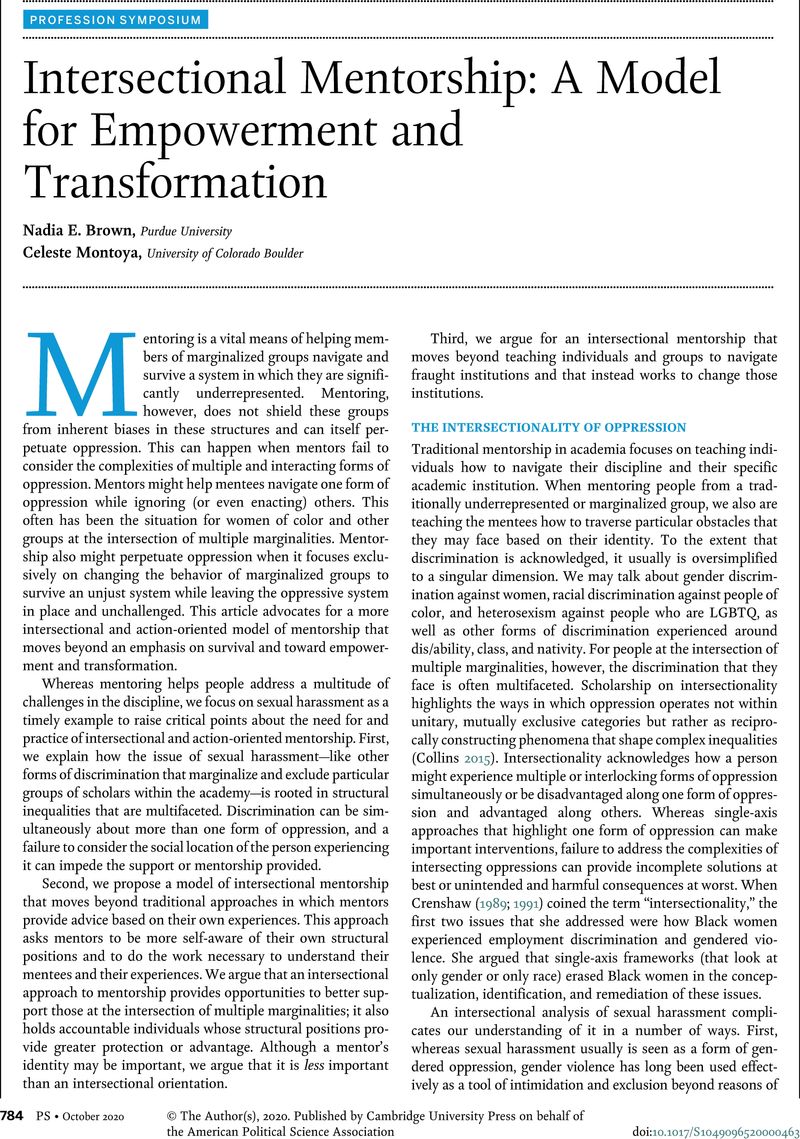Crossref Citations
This article has been cited by the following publications. This list is generated based on data provided by Crossref.
Bowleg, Lisa
2021.
“The Master’s Tools Will Never Dismantle the Master’s House”: Ten Critical Lessons for Black and Other Health Equity Researchers of Color.
Health Education & Behavior,
Vol. 48,
Issue. 3,
p.
237.
Manongsong, Ague Mae
and
Ghosh, Rajashi
2023.
Living at the Intersections of Race and Gender in Diversified Mentoring: Experiences of Minoritized Women Leaders in Higher Education.
Advances in Developing Human Resources,
Vol. 25,
Issue. 4,
p.
247.
Stoff, David M.
Bowleg, Lisa
del Río-González, Ana María
Rodriguez-Diaz, Carlos E.
and
Zea, Maria Cecilia
2023.
Critical Perspectives on Expanding Racial/Ethnic Diversity in the HIV Research Workforce: Comorbidities and Mentoring.
Health Education & Behavior,
Vol. 50,
Issue. 6,
p.
748.
2023.
Mask, Ashley
2023.
Mentoring Up, Down, and Sideways: Reciprocity and Care in the Museum Education Field.
Journal of Museum Education,
Vol. 48,
Issue. 4,
p.
391.
Evans, Michelle D.
Knepper, Hillary J.
and
Henley, Tiffany J.
2023.
An intersectional consideration of mentoring in public administration.
Journal of Public Affairs Education,
Vol. 29,
Issue. 4,
p.
421.
Monari, Patrick K.
Hammond, Emma R.
Malone, Candice L.
Cuarenta, Amelia
Hiura, Lisa C.
Wallace, Kelly J.
Taylor, Linzie
and
Pradhan, Devaleena S.
2023.
Leveraging individual power to improve racial equity in academia.
Hormones and Behavior,
Vol. 152,
Issue. ,
p.
105358.
Tan, Edna
and
Krishnamoorthy, Rishi
2024.
Intergenerational Asian diaspora mentoring in the academy: mapping the terrain of allied political struggles through critical relational ethnography.
Diaspora, Indigenous, and Minority Education,
p.
1.
Adida, Claire L.
Lo, Adeline
Rhee, Inbok
and
Williams, Sam
2024.
Do equity, diversity and inclusion (EDI) requirements change student political attitudes?.
Politics, Groups, and Identities,
Vol. 12,
Issue. 4,
p.
958.
Jaramillo, Jahn
Forney, Derrick
Casanova, Felicia O.
Shahid, Naysha N.
Boga, Devina J.
Reyes, Nequiel
Schmidt, Renae
Dale, Sannisha K.
Feaster, Daniel J.
and
Horigian, Viviana E.
2024.
A commentary on forging a path for CHANGE: culturally focused HIV training for the next generation in pursuit of equity.
Critical Public Health,
Vol. 34,
Issue. 1,
p.
1.
Sevelius, Jae M.
Harris, Orlando O.
and
Bowleg, Lisa
2024.
Intersectional Mentorship in Academic Medicine: A Conceptual Review.
International Journal of Environmental Research and Public Health,
Vol. 21,
Issue. 4,
p.
503.
Lim, Sok Mui
and
Ibrahim, Yaacob
2024.
Empowering the Next Generation: Navigating Challenges and Opportunities in the Modern Workforce Through Coaching and Mentorship.
Singapore Labour Journal,
Vol. 03,
Issue. 01,
p.
123.
Taff, Steven D.
Moreno, Carlos E.
Nuwere, Efekona
West-Bruce, Stacy
and
Malfitano, Ana P.S.
2025.
Equity, Diversity, and Inclusion in Healthcare.
p.
119.



